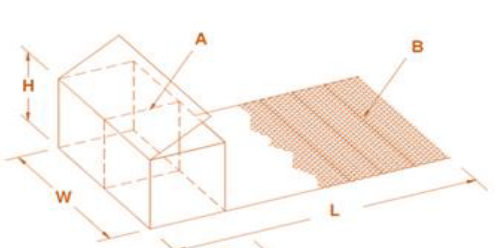The reinforced earth system consists of continuous steel reinforcement, made of hexagonal wire mesh (double mesh) placed horizontally with embankment compressed over it. The GABION-type facade unit of the system is fully integrated with the steel reinforcement and is formed by connecting the rear frame and baffles to the main ground reinforcement.
The dimensions and wires are the same as GABIONS and the length of the reinforcing mesh can be made from 2.00m to 9.00m
The reinforced earth grid system is intended to be used for:
– earth retaining structures (vertical, struck or inclined walls, bridge reinforcements, bulk storage facilities) with retaining face placed between reinforcing layers.
– reinforcement of steep slopes with integrated wire box units.
– self-supporting embankments.

STANDARDS
EAD 200026-00-0102 Steel Wire Mesh Systems for Reinforced Fill, April 2016
EN 10218-1:2012 Steel wire and wire products. General. Part 1: Test methods
EN 10218-2:2012 Steel wire and wire products. General. Part 2: Wire dimensions and tolerances
EN 10223-3:2013 Steel wire and wire products for fencing and netting. Part 3: Hexagonal steel wire mesh products for civil engineering purposes
EN 10244-1:2009 Steel wire and wire products. Non-ferrous metallic coatings on steel wire. Part 1: General principles
EN 10244-2:2009 Steel wire and wire products. Non-ferrous metallic coatings on steel wire. Part 2: Zinc or zinc alloy coatings
EN 10245-1:2011 Steel wire and wire products. Organic coatings on steel wire. Part 1: General rules
EN 10245-2:2011 Steel wire and wire products. Organic coatings on steel wire. Part 2: PVC finished wire
EN 10245-3:2011 Steel wire and wire products – Organic coatings on steel wire – Part 3: PE coated wire
EN 10270-1:2011+A1:2017 Steel wire for mechanical springs. Part 1: Patented cold drawn unalloyed spring steel wire
EN 10270-2:2011 Steel wire for mechanical springs. Part 2: Oil hardened and tempered spring steel wire
EN 10270-3:2011 Steel wire for mechanical springs. Part 3: Stainless spring steel wire
ENISO 527-1:2019 Plastics. Determination of tensile properties. Part 1: General principles (ISO 527-1:2012)
EN ISO 527-2:2012 Plastics. Determination of tensile properties. Part 2: Test conditions for moulding and extrusion plastics (ISO 527-2:2012)
EN ISO 868:2003 Plastics and ebonite. Determination of indentation hardness by means of a durometer (Shore hardness) (ISO 868:2003)
EN ISO 1183-1:2019 Plastics. Methods for determining the density of non-cellular plastics. Part 1: Immersion method, liquid pyknometer method and titration method (ISO 1183-1:2019)
EN ISO 1183-2:2019 Plastics. Methods for determining the density of non-cellular plastics. Part 2: Density gradient column method (ISO 1183-2:2019)
EN ISO 1183-3:1999 Plastics. Methods for determining the density of non-cellular plastics. Part 3: Gas pyknometer method (ISO 1183-3:1999)
EN ISO 2039-2:1999 Plastics. Determination of hardness. Part 2: Rockwell hardness (ISO 2039-2:1987)
EN ISO 4892-3:2016 Plastics. Methods of exposure to laboratory light sources. Part 3: Fluorescent UV lamps (ISO 4892-3:2016)
EN ISO 6892-1: 2019 Metallic materials. Tensile testing. Part 1: Method of test at room temperature (ISO 6892-1:2019)
EN ISO 6988:1994 Metallic and other nonorganic coatings. Sulfur dioxide test with general condensation of moisture (ISO 6988:1985)
EN ISO 7500-1:2018 Metallic materials. Verification of static uniaxial testing machines. Part 1: Tension/ compression testing machines. Verification and calibration of the force-measuring system
EN ISO 9223:2012 Corrosion of metals and alloys. Corrosivity of atmospheres. Classification, determination and estimation (ISO 9223:2012)
EN ISO 9227:2017 Corrosion tests in artificial atmospheres. Salt spray tests (ISO 9227: 2017)
